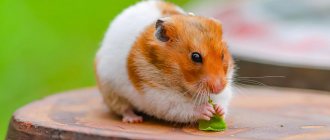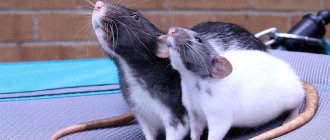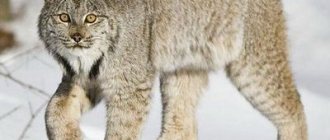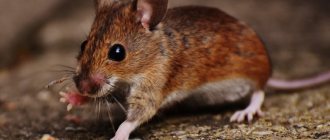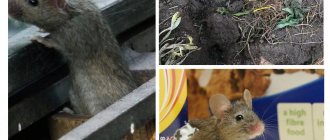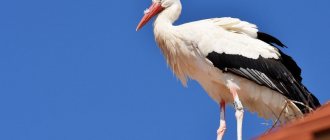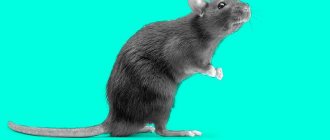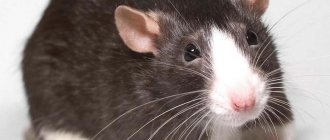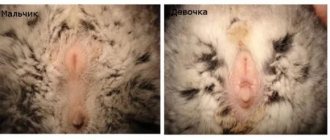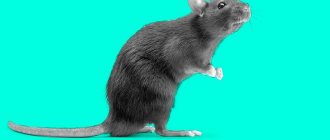Rodents (Rodentia) are a group of mammals that numbers more than 2 thousand living species. Distinctive features of rodents are the upper and lower pairs of constantly growing rootless incisors. Rodents are the largest order in the class of mammals.
As evidenced by fossils, the evolutionary history of rodents began in North America, 56 million years ago, during the late Paleocene era. However, some species are thought to have originated in Eurasia, so the age of the order Rodentia is certainly older.
Classification
Rodents are classified in the following taxonomic hierarchy:
- Domain: Eukaryotes;
- Kingdom: Animals;
- Phylum: Chordata;
- Class: Mammals;
- Order: Rodents.
Scientists agree on the definitions of most families, but they have historically disagreed about organizing families into larger groups, namely suborders. In early classifications, suborders were generally omitted, and families were grouped into superfamilies. The latest official classification identifies five suborders, whose representatives have similar features:
- Porcupines (Hystricomorpha): There are approximately 300 species of porcupine rodents living today. Members of this suborder include agoutis, porcupines, mole rats, nutrias, chinchillas, capybaras and many others. Hystricomorpha rodents have a unique arrangement of jaw muscles that sets them apart from other rodents.
- Myomorpha: There are about 1,400 species of living mouse-like rodents. This group includes mice, rats, hamsters, voles, lemmings, jerboas, muskrats, etc. Most species of mouse-like rodents are nocturnal; they feed on seeds and grains.
- Anomaluromorpha: has nine species, including the spiny-tailed squirrels, Pela's spiny-tails, long-eared spinytails, Cape striders, etc. Some members of this suborder (except the spiny-tailed squirrels) have flight membranes that allow them to glide.
- Squirrel-like rodents (Sciuromorpha): There are about 273 species of squirrel-like rodents. Members of this suborder include squirrels, chipmunks, marmots, flying squirrels, etc. Squirrels have a unique arrangement of jaw muscles that distinguishes them from all other rodents.
- Beavers (Castorimorpha) : has about 100 species from 3 families: beavers, gophers and pouchhoppers. This suborder was identified in 2005.
Mara
The animal lives on the rocky plateaus of Argentina and Patagonia and looks slightly like a kangaroo. Mara is a distant relative of the well-known domestic guinea pig and belongs to the half-ungulate family. An adult rodent weighs about 20 kilograms, and its body length often reaches 50 centimeters.
In Patagonia, locals call the maru the lowland hare, since the rodent's hind legs are much longer than its front ones and help it jump long distances. In addition, the habits of the mara are similar to those of a hare. When an animal runs away from a predator, it jumps in a zigzag pattern, straining all 4 legs at the same time.
Distribution and habitat
Rodents are a widespread order of mammals. They are found in most terrestrial habitats and are absent only from Antarctica, New Zealand and some oceanic islands.
Ecologically they are incredibly diverse. Some species spend their entire lives on the surface of the earth, in the forest floor or tree canopy; others rarely emerge from the ground. Some species are primarily aquatic, while others are adapted to live in deserts.
Crested porcupine
Another name for the animal is the crested porcupine or typical porcupine. The largest and most famous representative of the Hystricidae family. The creatures live in Europe, India, North Africa, China, Transcaucasia and Iraq. The body length of an adult is over 85 centimeters, and its weight is 25-27 kilograms.
A special feature of porcupines is the long quills that line their backs and serve as a means of defense against natural enemies. In dangerous situations, the animal throws out needles. They dig into the attacker's body and cause severe pain. The most common victims of tufted porcupines are curious dogs, farm animals and children.
Dimensions
Capybaras
The rodent order has a varied range of body sizes. One of the smallest rodents is the swamp hamster (Delanymys brooksi), common in the swamps and mountain forests of Africa. It weighs from 5 to 7 grams and has a length of 5 to 6 cm. The largest rodent is the capybara (Hydrochoerus hydrochaeris) from Central and South America, which weighs from 35 to 66 kg and has a height at the withers of 50 to 60 cm, and body length from 100 to 135 cm. Some extinct species were even larger, reaching the size of a black bear or a small rhinoceros. The largest rodent (Josephoartigasia monesi), lived about two to four million years ago, during the Pleistocene and Pliocene eras; According to some estimates, it was about 3 meters long and weighed almost 1000 kg.
Rodents
Hamsters, nutria, ground squirrels, porcupines - all these animals are united by belonging to the order of rodents, the most numerous in the class of mammals. Today there are 2606 species of these animals. Unfortunately, 49 species have become extinct over the past 5 centuries, and some are now on the verge of extinction.
Description
Common flying squirrel
All rodents have continuously growing rootless incisors with a hard enamel layer at the front of each tooth and softer dentin. Gnawing on hard food constantly wears down the incisors. The absence of canines in rodents results in a gap or diastema between the incisors and molars. They have 12 to 22 teeth
The structure of the jaw ensures that the incisors, upper and lower premolars, and molars do not meet while the animal chews. Powerful muscles attached to the jaw and skull provide the force for chewing and gnawing.
The body shape of tree squirrels may be a model for the earliest and now extinct rodents of the genus Paramys. With their ability to grip bark with their claws, squirrels are adept at climbing tree trunks, running along branches, and jumping onto nearby trees; but they are equally agile on land, and some are able swimmers.
The specialized body shapes of other rodent species tie them to specific habitats. Some strictly arboreal species have a prehensile tail; others glide from tree to tree using lethal leathery membranes located between the fore and hind limbs (for example, the flying squirrel). Highly specialized burrowing rodents, including mole rats, mole rats, and ground squirrels, have cylindrical bodies, strong incisors, small eyes and ears, and large forelimbs with powerful burrowing claws.
Semi-aquatic rodents such as beavers, muskrats, nutria and water rats have special features that allow them to forage in aquatic environments while still living in earthen burrows. Terrestrial jumping species, such as kangaroo jumpers, jerboas and gerbils, have short forelimbs, elongated and powerful hind limbs, and a long tail used for balance.
Regardless of body shape, all rodents have the same adaptations that can be used for different purposes: cutting grass, opening nuts, killing their prey, digging tunnels, felling trees, etc.
Basic characteristics of rodents
The main characteristics of rodents include:
- one pair of incisors on each jaw (upper and lower);
- incisors grow continuously;
- incisors have no enamel on the back of the tooth (and wear down with use);
- large gap (diastema) behind the incisors;
- no fangs;
- complex masticatory muscles;
- there is a fully developed baculum.
Castoroides or giant beaver
Castoroides, also known as the giant beaver, is an extinct North American rodent that lived during the Pleistocene. It weighed up to 275 pounds, had a body length of 6.2 to 7.2 feet in length, and it is unknown how much additional length the tail might have added to this figure. Castoroides are the largest of all beavers that have ever lived on our planet.
This species differed from modern ones in that the extinct animal had short hind legs, wide teeth, and a smaller brain than their modern counterparts. The first fossils of the Castoroides species were found in Ohio in the 1830s. Since then, remains of Castoroides have been found throughout America, from Alaska to Florida. Especially with many finds archaeologists have discovered in Indiana, Illinois and near the Great Lakes.
Nutrition
Rodents eat a variety of foods, including leaves, fruits, seeds and small invertebrates. Cellulose foods are digested in the cecum (a sac in the digestive tract that contains bacteria that can break down solid plant material into a digestible form). Food is either eaten where it is collected, or it is brought into burrows for storage (for example, gopher rats, Gambian rats, hamsters, etc.). Species living in arid habitats and on oceanic islands can obtain essential fluids from their food.
Mice of Gough Island
Situated in the South Atlantic, Gough Island has been overrun by approximately two million mice. Uninhabited areas have become an ideal breeding ground for them. It is noteworthy that rodents are twice as large as their counterparts living in the civilized world. Every year, 1.6 million petrel chicks are born on the island, and 1.2 million of them are eaten by mice.
Shearwaters are also eaten by black rats that have settled on the Tristan da Cunha archipelago, where, as on Gough Island, these rodents have no natural predators. Experts, in turn, continue to search for the best method for exterminating these pests, because even one surviving pregnant female can give birth to new rats that will multiply quickly. But scientists do not lose hope. In 2009, complete eradication of rats was achieved on Rat Island (Alaska), where rodents lived for 230 years.
Behavior and reproduction
Some rodents are capable of constructing a wide variety of houses; These range from holes in trees and rocks, simple burrows in nests, structures made of leaves and sticks in treetops, to complex underground tunnels, and the construction of dams on rivers and streams.
Rodents can be diurnal or nocturnal, or are sometimes active for part of the day and night. Representatives of this order can be active throughout the year, but some species experience periods of rest or deep winter hibernation.
The timing and frequency of reproduction, length of gestation, and litter size vary greatly from species to species. For example, the gray rat (Rattus norvegicus) can produce up to 22 litters at a time, and the house mouse (Mus musculus) can produce up to 14 litters annually. Population sizes can remain stable or fluctuate, and some species, especially lemmings, migrate when populations become excessively large.
Viking rats
In 2014, an unusually large rat, more than 15 inches, appeared in the kitchen of the Bengtsson-Korsas family (Solna, Sweden). The rodent made passages in wood and concrete to get into the room. To destroy the pest, homeowners used the largest trap. The rat was so large that only its head could fit into the rat trap. She did not die immediately, but suffocated in her tunnel. The family first realized something was wrong when their cat, Enoch, became afraid to go into the kitchen.
Based on a number of studies and observations conducted in Europe, the UK and the USA, the appearance of so-called Viking rats may indicate abnormal development of individuals and various types of mutations. Experts who have monitored the rodents say they are twice the size of regular rats. In Dublin, exterminators caught a 24-inch rat in an apartment.
In addition, Viking rats are immune to poisons. Bromadiolone no longer works on them. According to a 2009 University of Huddersfield study, genetic mutation and immunity to poisons go hand in hand in this case, forcing specialists to create new, more effective poisonous drugs.
Soviet chinchilla
The largest breed of domestic rabbits, bred for their fur on private farms in Russia and the CIS countries. It was obtained by crossing American small chinchillas with white giant rabbits. The bred animal is large in size: body length - 70-75 centimeters, weight - 5-6 kilograms, subject to proper feeding and maintenance. A feature of Soviet chinchillas was their high fertility. A female gives birth to up to 15 cubs per year, which gain a weight of 2 kilograms in 60 days.
Speckled gopher
The speckled gopher or prairie dog is the most common rodent in Eastern Europe, the banks of the Danube and Volga. They also inhabit countries such as Belarus and Ukraine. Speckled gophers live in dry meadows, forest belts, plantings and near water bodies. The body length of a mature prairie dog reaches 25 centimeters, and its weight does not exceed 700 grams. The gopher, having left its parent's nest, begins to equip its house. In it he raises offspring, spends the summer and hibernates.
Food
Rodents love seeds, nuts, grains of various cereals, as well as lettuce, spinach, cabbage, clover and dandelion. They also really like dry corn kernels, raisins, apples and carrots. Rodents should never be given sweets, chocolate or sweet cookies! And also lemons, oranges and onions. From time to time you can pamper your pets with crackers, and treat a rat or mouse with a piece of cheese. Be sure to put a branch of a fruit tree or a special mineral block in the cage - rodents will grind down their teeth. The fact is that rodents’ incisors grow throughout their lives. And if they are not ground down, they can grow so long that the animal will not be able to close its mouth and will not be able to eat. The animal will die of hunger, even if there are plenty of treats nearby.
Video
Photo
Read on our website interesting articles about country pests: moles, gophers, hamsters.
At all times, mice lived next to humans and caused damage to the household. In order to protect yourself and your loved ones from diseases and protect property from damage, you should regularly take measures to get rid of these pests.
Flanders
The animal was nicknamed the Belgian giant because of its incredible size among the representatives of the rabbit family. An adult rodent grows up to 70 centimeters in length, and particularly well-fed individuals can weigh 24-25 kilograms.
Flanders are bred to obtain skins with thick, beautiful fur, from which sheepskin coats, mittens, hats, and nutritious meat are sewn. Less commonly, this breed is kept as a decorative pet. Belgian giants are famous for their fertility. A person who decides to engage in rabbit breeding by purchasing a pair of flanders will become the owner of a large rabbit farm in 2 years.
Long observations of the behavior of Flanders allowed scientists to conclude that they are very smart and friendly. Rodents easily make contact with people and get along with other pets in the house.

